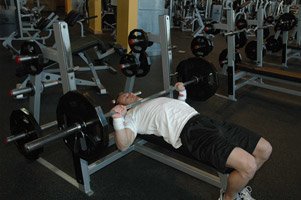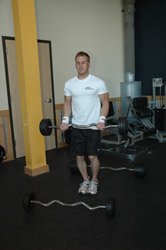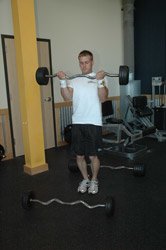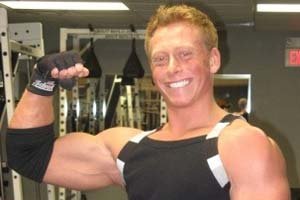HIT Technique 1
You are taught from early on that full-range-of-motion reps are the way to go if you are looking to increase size and strength to your physique. How can partial reps help if you are not performing the full range of motion? First you need to realize that to perform a partial rep set correctly you start by using full-range-of-motion reps until you can't do any more in full-range-of-motion form.
Instead of stopping the set you continue to perform partial reps with as much range of motion as possible to extend the set and drive the muscle into complete failure. Partial reps were a favorite of Dorian Yates. He was known to do them until he was not able to move the weight at ALL.
I perform 2 warm-up sets before each working set.
Legs:
- Squats: 1x12 below parallel, 1x4 At parallel, 1x failure above parallel
- Leg Press: 1x10 4 partial reps
- Leg Extensions: 1x12 3-5 partial reps
- Seated Leg Curl: 1x12 3-5 partial reps, 1x20 Failure on partial reps
 Click Here For A Printable Log Of Legs.
Click Here For A Printable Log Of Legs.
Chest and Triceps:
- Flat Barbell Bench Press: 1x8 2-4 partial reps
- Incline Barbell Bench Press: 1x8 2-4 partial reps
- Incline Dumbbell Flyes: 1x12 1-2 partial reps
- Lying Triceps Extensions: 1x10 2-3 partial reps
- Triangle Bar Push-downs: 1x15 3-5 partial reps
 Click Here For A Printable Log Of Chest & Triceps.
Click Here For A Printable Log Of Chest & Triceps.
Back and Biceps:
- Underhand-Grip Barbell Rows: 2x10 2 partial reps
- Wide-Grip Pull-ups: 1x12 3-5 partial Reps
- Barbell Curls: 2x12 2-4 partial reps
 Click Here For A Printable Log Of Back & Biceps.
Click Here For A Printable Log Of Back & Biceps.
Shoulders:
- Standing Military Press: 2x8 2-4 partial reps
- Dumbbell Side Laterals: 1x12 failure with the partial reps
- Dumbbell Rear-Delt Flyes: 1x15 failure with the partial reps
 Click Here For A Printable Log Of Shoulders.
Click Here For A Printable Log Of Shoulders.
One note I need to make, when performing the partial reps; form still should be good throughout. There is a big difference between extending a set with partial reps and extending a set with cheating.
If you are cheating and still can not do the full range of motion you are using way too much weight. This will only lead to wasted effort and in some cases injury.
Partial reps are to be performed in good form after you perform your initial reps in good form. No cheating is to be done in this type routine. If performed correctly partial reps are an excellent way to extend your sets and increase the intensity to your HIT. So give my HIT Partial Rep Routine a try.
HIT Technique 2
The next HIT technique we will discuss is the Triple Drop Sets. A triple drop set is performed by doing as many reps as you can with one weight to failure then quickly decrease the weight and continue performing reps until you fail again after that you decrease the weight one last time and perform as many reps to failure.
This is an amazing way to pump the maximum amount of blood into the target muscle and also bring the muscle to absolute failure. As you can see you are doing three sets in a row. If you use the utmost intensity only one triple drop set per exercise is needed in HIT fashion.
Below is my HIT Triple Drop Set Program:
Note: I warm up with 2 straight sets before I perform my 1 Triple Drop Set for all exercises. Also I usually pick a weight for the first set of the triple drop set that makes me fail in the 8-12 rep range then take the next 2 set to failure not worrying about number of reps reached.
Legs:
- Machine Leg Press: First set 12 reps, next 2 to failure for all leg exercises
- Leg Extension
- Seated Leg Curl
- Standing Calf Raise
 Click Here For A Printable Log Of Legs.
Click Here For A Printable Log Of Legs.
Chest and Triceps:
- Incline Chest Press Machine: First set 8 rep, next 2 to failure for both incline and flat presses
- Flat Chest Press Machine
- Pec Dec Flyes: First set 12 reps, next 2 to failure
- Triceps Dip Machine
 Click Here For A Printable Log Of Chest & Triceps.
Click Here For A Printable Log Of Chest & Triceps.
Back and Biceps:
- Close Grip Pull-downs: First set 12 reps, next 2 to failure for all back exercises
- T-bar Rows: Bar in the corner
- Hyperextensions: Use plates for resistance
- Preacher Curl Machine
 Click Here For A Printable Log Of Back & Biceps.
Click Here For A Printable Log Of Back & Biceps.
Shoulders:
- Dumbbell Side Laterals: First set 12 reps, next 2 to failure
- Machine Shoulder Presses: First set 8 reps, next 2 to failure
- Rear-Delt Raise: First set 15 reps, next 2 to failure
 Click Here For A Printable Log Of Shoulders.
Click Here For A Printable Log Of Shoulders.
This routine is made up for someone that lifts alone. All the exercises are picked so that weight can be lowered in the shortest amount of time so the set can be resumed as quick as possible. This is key whenever doing any drop set exercises.
Nothing will ruin the intensity of a drop set more than having to take 20+ second to unload and re-clip a bar. If you are lucky to workout with a training partner or two you will have many more exercises to choose from because they can help strip off the weight once you reach failure.
If you are like most of the lifters out there that have to got at this iron sport solo, give my HIT Triple Drop Set program a try. It will really help bring some intensity to your HIT.
HIT Technique 3
Rest Pause sets are an excellent HIT technique to help raise the intensity of any workout. There are two different variations of the Rest Pause Sets that I like to use, the Single-Rep Rest Pause and the Post-Set Rest Pause Set. I will discuss the Single-Rep Rest Pause Set here and the Post-Set Rest Pause Set next.
When you perform a Single-Rep Rest Pause Set choose a weight that is about 90% of your 1RM. Perform one rep in perfect form, rest for 5-10 second, then perform your next rep resting again after one more rep. Continue performing all your reps one at a time with a 5-10 second rest in between each.
The Idea behind the Single-Rep Rest Pause Set is you are able to you maximum amount of weight and because of the little rest your form stays perfect throughout the entire set. Below is my routine for a HIT Single-Rep Rest Pause Set:
Legs:
Rest 10 seconds between each single rep rest pause for all leg exercises.
- Squats: 1x5
- Leg Press: 1x12
- Barbell Stiff-Legged Deadlift: 1x8
 Click Here For A Printable Log Of Legs.
Click Here For A Printable Log Of Legs.
Chest/Triceps:
Rest 8 seconds between each single-rep rest pause for all chest/triceps exercises.
- Flat Barbell Bench Press: 1x8
- Incline Barbell Bench Press: 1x8
- Decline Barbell Bench Press: 1x8
- Close-Grip Bench Press: 2x12
 Click Here For A Printable Log Of Chest/Triceps.
Click Here For A Printable Log Of Chest/Triceps.
Back/Biceps:
Rest 8 seconds between each single rep rest pause for all Back/Bicep exercises.
- Deadlifts 3x5
- Barbell Curls 2x12
 Click Here For A Printable Log Of Back/Biceps.
Click Here For A Printable Log Of Back/Biceps.
The Single-Rep Rest Pause Technique works best for pressing compound movements where you are able to rack the weight during your rest periods between reps. Pulling exercises like rows and curls require you to hold the weight throughout which fatigues your grip so I decided to ditch all rowing exercises and replace them with deadlifts.

 Click Image To Enlarge.
Click Image To Enlarge. The Single-Rep Rest Pause Technique
Works Best For Pressing Compound Movements.
Rack the barbell between each rep when performing the barbell curls.
Shoulders:
Rest 5 seconds between each single-rep rest pause for all shoulder exercises.
- Seated dumbbell shoulder presses: 1x10
- Dumbbell side laterals: 1x12
- Bent-over rear-delt dumbbell flyes: 1x12
 Click Here For A Printable Log Of Shoulders.
Click Here For A Printable Log Of Shoulders.
You should hold the contraction for 2-3 seconds during each rep of the laterals and the rear-delt flyes.
The Single-Rep Rest Pause Routine is an excellent way to increase both size and strength in a safe manner. The little rest between reps will help you keep perfect form and will ensure you are able to use more weight for more reps than if you did straight sets alone.
More weight for more reps is a proven equation for continued growth. If you want to increase your intensity and continue to make those improvements give my Single-Rep Rest Pause Routine a try.
HIT Technique 4
The last HIT technique that I will discuss is the Post-Set Rest Pause Set. Instead of resting for a short while between each rep like in the single-rep rest pause set, we will perform a normal set with continuous reps until we reach failure. Rack the weight and then take a 5-10 second rest, then continue and try to pump out as many reps to failure once more.
This rest-pause technique triggers the use of more slow twitch muscle fibers as you are increasing the overall reps in the set. This technique really makes sure that you bring your muscles to absolute failure.
Below is my Post-Set Rest Pause Routine:
Remember to pick a weight that you will reach failure at in the rep range that is laid out for you. Also make sure that you do at least 2 warm-up sets before you move to your working sets.
Rest 10 seconds post set then continue to failure.
Legs:
- Squats: 1x8
- Hack Squats: 1x12
- Lying Leg Curls: 1x10
- Seated Calf Raises: 1x20
Rest 8 seconds post set then continue to failure.
 Click Here For A Printable Log Of Legs.
Click Here For A Printable Log Of Legs.
Chest:
- Flat Barbell Bench Press: 1x10
- Decline Barbell Bench Press: 1x10
- Incline Barbell Bench Press: 1x10
- Weighted Dips: 2x8 (Keep body as vertical as possible looking for this exercise to stimulate the triceps)
Rest 8 Seconds post set then continue to failure.
 Click Here For A Printable Log Of Chest.
Click Here For A Printable Log Of Chest.
Back/Biceps:
- Weighted Pull-ups: 2x12
- Underhand-Grip Barbell Rows: 2x8
- Low Cable Rows: 1x10
- Barbell Curls: 2x8
Rest 5 seconds post set then continue to failure.
 Click Here For A Printable Log Of Back/Biceps.
Click Here For A Printable Log Of Back/Biceps.
Shoulders:
 Click Here For A Printable Log Of Shoulders.
Click Here For A Printable Log Of Shoulders.
Conclusion
There you have it. Excellent high intensity training techniques with routines all laid out for you, to help you increase your intensity and get to the next level. These techniques are a little different from the next but the one thing that they all have in common, is each, if performed with all-out effort will increase your intensity in the gym. Increased intensity is always a sure way to make improvements.
You could decide to use this program laid out for you as is or mix with others. As long as you follow the guidelines and keep that intensity through the roof you will be fine.
If you have any questions regarding HIT or Fitness in general please send me an email. I would be glad to answer them for you. I hope you enjoyed my HIT Technique Routine Series.



